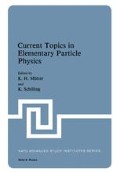Abstract
The possibility that weak and electromagnetic interactions are described, in a unified manner, by a spontaneously broken SU(2)L × U(1) gauge theory1 has gained wide experimental support over the past decade. However, one of the least satisfactory aspects of this theory is its reliance on elementary scalar fields to spontaneously break the gauge symmetry and, via the Higgs mechanism, generate masses for the vector bosons.
Access this chapter
Tax calculation will be finalised at checkout
Purchases are for personal use only
Preview
Unable to display preview. Download preview PDF.
References and Footnotes
S. Weinberg, Phys.Rev.Lett. 19, 1264,(1967); A. Salam, in Elementary Particle Physics: Relativistic Groups and Analyticity (Nobel Symposium No. 8), edited by N. Svartholm (Almgrjist and Wiksell, Stockholm, 1968), p. 367. We confine our attention to the minimal SU(2)L x U(1) model considered by these authors, wherein the scalar fields are represented by a single, complex SU(2)L doublet.
L. Susskind, Phys.Rev. D20, 2619, (1979).
T. Appelquist and C. Bernard, Phys.Rev. D22, 200, (1980).
A. C. Longhitano, Phys.Rev. D22 1166, (1980) A. C. Longhitano, Yale Univ. Report YTP80-27, 1980 (unpublished).
Counterterms can be generated which are not CP invariant, and the heavy-Higgs-boson physics represented by these structures when quarks are included in the theory is currently under investigation by the author.
This is only true in Landau gauge, which we adopt. In this gauge, the Fadeev-Popov ghosts decouple from the scalar fields.
P. Langacker et al., Univ. of Penn. Report No. C00-3071-243, 1979 (unpublished).
M. Veltman, Phys.Lett. 91B, 95, (1980).
This agrees with the results of a calculation of K appearing in W. A. Bardeen et al., Nucl.Phys. B46, 319, (1972).
Author information
Authors and Affiliations
Editor information
Editors and Affiliations
Rights and permissions
Copyright information
© 1981 Plenum Press, New York
About this chapter
Cite this chapter
Longhitano, A.C. (1981). Heavy Higgs Bosons. In: Mütter, K.H., Schilling, K. (eds) Current Topics in Elementary Particle Physics. NATO Advanced Study Institutes Series, vol 70. Springer, Boston, MA. https://doi.org/10.1007/978-1-4684-8279-9_9
Download citation
DOI: https://doi.org/10.1007/978-1-4684-8279-9_9
Publisher Name: Springer, Boston, MA
Print ISBN: 978-1-4684-8281-2
Online ISBN: 978-1-4684-8279-9
eBook Packages: Springer Book Archive

